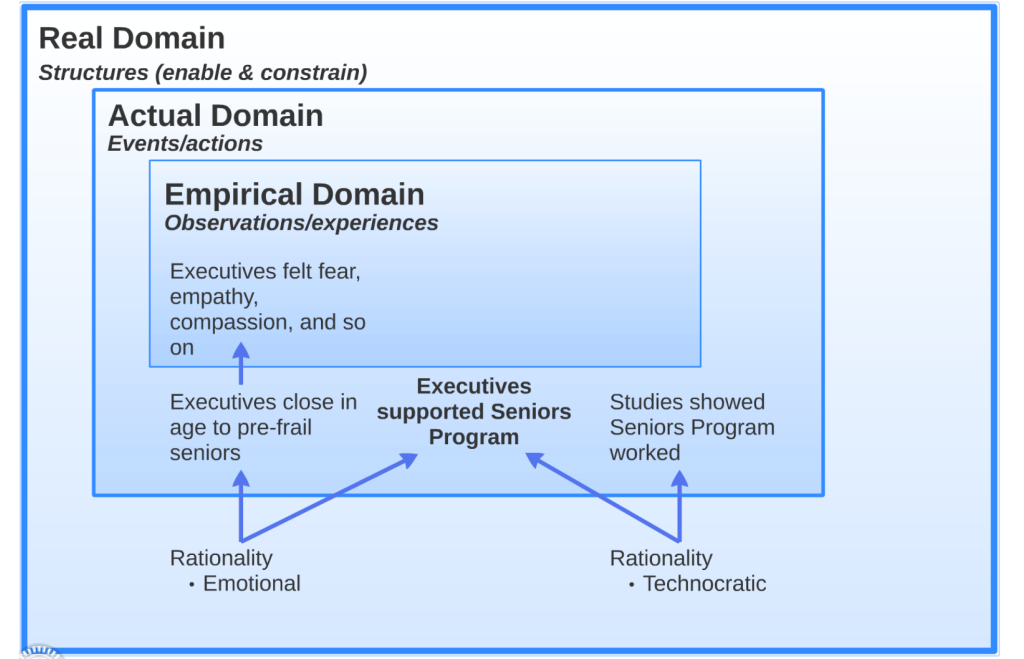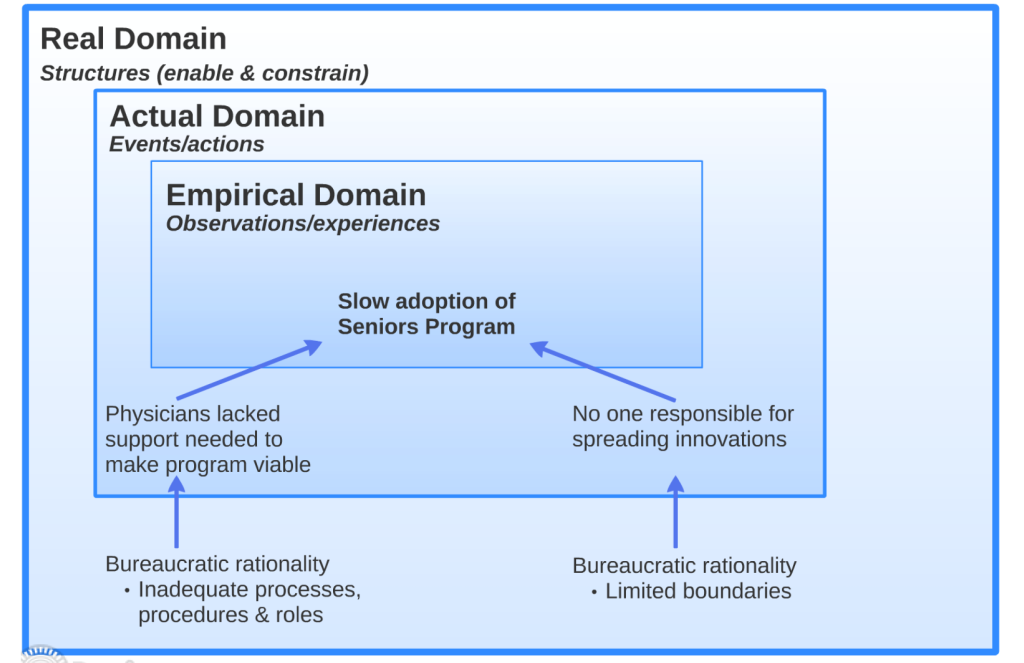Rationality as social structures
Section audio
As discussed in Chapter III, rationality is a social structure that enables and constrains actions. The following sections first look at how rationality enables action, followed by a discussion of how they constrain.
Rationality Enables Action
Chapter V described rationality as the process through which we assess our environment, make decisions and evaluate choices. By applying various forms of rationality, we build our understanding of the world and decide how to operate within it. Rationality, thus, enables actions through two mechanisms.
- First, it justifies actions.
- Second, through bureaucratic rationality, it organizes our activities[1]
Rationality Justifies Action
Rationality enables actions as it is how we justify our behaviours and convince members in our social group to do certain things. We want others to perceive that we are rational, and thus we choose actions that create that perception.
Considering the Seniors Program from Appendix 1, for example, the fellowship used technocratic rationality to demonstrate their intervention measurably improved the frailty in a seniors population. Through the study they performed, they learned how to delay frailty’s onset. They then used those results to convince healthcare managers and physicians to adopt the program.
Moreover, interviews with the fellowship surfaced other ways rationality enabled action.[2] The fellowship noted that many managers approached the age of the population targeted by the program. That is, the Seniors Program targeted pre-frail seniors, and the managers of the BC Health Authority were getting to the age where they started to think they might be pre-frail seniors. This realization led some managers to support the program’s spread in the healthcare region.
This is an example of emotional rationality. The managers’ sense of affiliation with the target population gave them feelings of, perhaps, fear, empathy, compassion, and so on. These feelings, in turn, led them to support the fellowship’s continuing efforts. The figure below diagrams the above description using a critical realist framework.

Bureaucratic Rationality Organizes Action
Many people roll their eyes with cynicism when they see the word bureaucracy. Bureaucratic rationality, however, plays an essential role in enabling action.
Recall from Chapter V how bureaucratic rationality defines how organizations do things. It does this by creating documents, boundaries, rules, processes, and procedures and roles.
- Organizations, thus, enable actions that comply with these bureaucratic structures.
- Importantly, it is through the creation of new bureaucratic structures that the organization undertakes new actions.
The development of the Seniors Program in Appendix 1 showed an example of this. The Project Charter documented the details of the collaboration between the Foundation and the BC and Nova Scotian Health Authorities. All participating organizations signed this document, committing themselves to form a team that attended the Training Fellowship. It was through this fellowship the Seniors Program came into existence.
The Project Charter embodied several bureaucratic rationalities.
- It was a document that codified the terms of the Seniors Project and embodied the agreement between all participating organizations to collaborate.
- It established boundaries by defining the scope of the project.
- It specified the rules of the collaboration by, for example, defining the process through which a party could end the partnership.
- It listed processes the fellowship followed, including decision-making activities.
- It identified key procedures and roles that stakeholders would perform throughout the program’s life.
Through the creation of the Project Charter, stakeholders produced new bureaucratic structures within their organizations. These new bureaucratic structures were the means through which stakeholders incorporated the activities needed to bring the Seniors Program to life into their organizations.
It was through bureaucratic rationality that the fellowship translated the Seniors Program from an idea into action. The figure below diagrams the above description using a critical realist framework.

Rationality Constrains Action
In the same way that rationality justifies an action, it can also argue against it. Similarly, though bureaucratic rationality provides the organizational structure for an activity, these structures can stifle attempts to act.[3]
Rationality Argues Against Taking Action
There are times when rationality leads us to conclude an activity is undesirable. Recall from Appendix 1 how the fellowship approached physicians and asked them to adopt the Seniors Program. These doctors used economic rationality and concluded it was financially unfeasible for them to do so.
Moreover, the fellowship initially wanted to develop a single intervention that the BC and Nova Scotian health authorities would implement. Differences in target patient populations and healthcare infrastructure prevented this, forcing the fellowship to make modifications for each region. This is an example of contextual (cultural) rationality preventing a unified approach.
Recall also how the fellowship wished to have the elderly perform a specific set of physical activities endorsed by research. The health of patients varied, however, and the fellowship had to modify prescribed physical activities to account for individual capabilities. In this way, the body rationality of individual patients prevented a unified approach.
The figure below diagrams the above description using a critical realist framework.

Bureaucratic rationality can stifle action.
A lack of appropriate bureaucratic structures can constrain individuals’ ability to act. As described earlier, physicians’ economic rationality prevented them from adopting the Seniors Program.
Having help from other healthcare professionals, such as physiotherapists or nurse practitioners, could have reduced doctors’ cost pressures. If this work were distributed among all these healthcare professionals, however, full implementation of the Seniors Program would require sharing the patient’s records. The IT and other communications infrastructure to achieve this level of coordination were not in existence at the time.
Thus, a lack of appropriate processes, procedures, and roles (that is, bureaucratic rationality), constrained physicians’ ability to share the workload of adopting this program.
Likewise, bureaucratic rationality limited the fellowship’s ability to spread the Seniors Program outside of the BC Health Authority region. Managers within health regions were responsible for overseeing healthcare within their geographic area. They had no mandate to promote the spread of innovations outside of their region, which limited support for the fellowship as they sought to expand their program across Canada.
This speaks to the bureaucratic rationality of boundaries. Bureaucratic rationality ‘bounded’ the scope of managers’ responsibility to a geographic region. The healthcare system’s bureaucratic structures had failed to assign responsibility for spreading innovations nation-wide to anyone. Thus, when the fellowship needed support to spread the Seniors Program nationally, they found that support lacking.
The figure below diagrams the above description using a critical realist framework.

Key Takeaways
- Rationality enables action
- Rationality justifies actions
- Bureaucratic rationality gives action structure
- Rationality constrains action
- Rationality argues against actions
- Bureaucratic rationality can stifle activity
- Anderson, B. C. (2019). Values, Rationality, and Power: Developing Organizational Wisdom--A Case Study of a Canadian Healthcare Authority. Bingley, United Kingdom: Emerald Group Publishing Limited. ↵
- Anderson, B. C. (2019). Values, Rationality, and Power: Developing Organizational Wisdom--A Case Study of a Canadian Healthcare Authority. Bingley, United Kingdom: Emerald Group Publishing Limited. ↵
- Anderson, B. C. (2019). Values, Rationality, and Power: Developing Organizational Wisdom--A Case Study of a Canadian Healthcare Authority. Bingley, United Kingdom: Emerald Group Publishing Limited. ↵
In the critical realist framework, social structures are forces in social settings that enable or constrain the actions people can take.
Technocratic rationality assumes the world (including humans) operate according to objective laws of nature. Through the application of the scientific method, practitioners gain an understanding of these objective natural laws, which in turn allows them to optimize systems of human activity.
A form of embodied rationality. Through emotional rationality, we use emotions to communicate within a group the status of its members and the collective as a whole. Internally, our emotions tell us what ends we desire, and the means we are willing to use to achieve them.
Bureaucratic rationality controls how individuals in organizations perform activities by defining and controlling knowledge through documentation, boundaries, rules, processes, and procedures/roles. It is a form of disembedded rationality.
A form of bureaucratic rationality. Bureaucracies use documents to classify and define objects, activities, and people (e.g. job descriptions, employment contracts)
A form of bureaucratic rationality. Bureaucracies define boundaries that classify who is responsible for which activity (e.g. finance department approves spending, teachers administer classroom lectures)
A form of bureaucratic rationality. Bureaucracies use rules to guide behavior and reduce the unpredictability of human discretion (e.g. sales associates must reply to customer e-mails within twenty-four hours)
A form of bureaucratic rationality. Bureaucracies use processes to standardize how individuals perform activities (e.g. the process of taking an order at a coffee shop)
A form of bureaucratic rationality. Bureaucracies use procedures and roles to eliminate unpredictability by defining discrete roles within the organization responsible for different procedures (e.g. the Vice President of Marketing is responsible for overseeing all the company's marketing activities).
Economic rationality is a means through which individuals make utility-maximizing decisions. It is a form of disembedded rationality.
A form of embedded rationality. Contextual (cultural) rationality presumes that what is rational can only be determined from within the social context (that is, culture) in which it occurs.
A form of embodied rationality. Body rationality argues that we gain knowledge through our senses. Experience gained through our senses forms the basis of intuition, which is a fast-act of logical reasoning. It is our intuition that allows us to act in complex situations when we lack the time or data needed to formally process our options.

